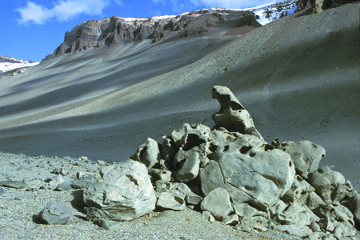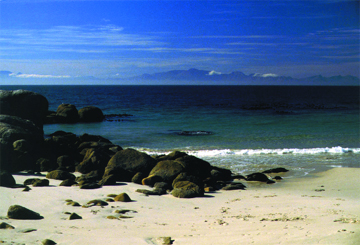Every month, we'd like to feature one of your photos from anywhere in the world and invite other readers to guess where it was taken. Look every month in the print Geotimes for a new photo. Following are clues, answers and winners from past issues.


| Do you have slides and photos you've
collected from field work or vacations? Every month, we'd like to feature one of your photos from anywhere in the world and invite other readers to guess where it was taken. Look every month in the print Geotimes for a new photo. Following are clues, answers and winners from past issues. |
 |
| Send answers for the August 2004 Where on Earth?
contest, which appears in the print magazine, to Geotimes by August
30 (or postmarked by this date). From those answers, Geotimes staff
will draw the names of 10 people who will win Where on Earth? T-shirts.
And from those 10 names, we will draw the names of two people who will win
a Brunton compass.
Click here
to submit a guess for this month's Where on Earth?
contest. Submit
photos for Where on Earth? |

|
Clues: 1. The dominant rock in this location is granodiorite gneiss, and the capstone layer on the mountains is dolerite. The vertical relief in the picture is about 700 meters. 2. Discovered in the early 20th century, this site was thought lifeless until the late 1970s. 3. No rain has been recorded in this Mars-like landscape over the past 2 million years. A salty lake in this location shares its name with a famed Casanova. Name this location. Scroll down for the answer |
| Answer: Wright Valley is one of Antarctica’s McMurdo Dry Valleys. It is located in the Transantarctic Mountains and hosts Don Juan Pond, the world’s saltiest lake. Photo courtesy of Kurt Cuffey. |
June
Winners
1. Michael Starbuck (Rolla, Mo.)
2. Robert L. Edwards (Boulder, Colo.)
3. Julie Palais (Arlington, Va.)
4. Bruce Malfait (Alexandria, Va.)
5. Charles C. Plummer (Sacramento, Calif.)
6. Charles R. Bentley (Madison, Wis.)
7. Linda Hansen (Arlington, Mass.)
8. Jonathan Berg (DeKalb, Ill.)
9. Richard E.A. Ipri (West Point, N.Y.)
10. Donald Schwert (Fargo, N.D.)

|
Clues: 1.Charles Darwin first described the 600-million-year-old granite pictured
in the foreground. The granite, intruded by dolerite dikes, is mined for
kaolin, which is used locally for making china and paper. 3. The area is well-known for its storms and rough seas, which legends say are caused by a mythical giant that is angry about the loss of a love. Since a Portuguese explorer first sailed to this location in the 15th century, the seas have claimed more than 25 large ships. Name this location. Scroll down for the answer |
| Answer: Check back soon for the answer! |
Check back later this month to find out who won July's Where
on Earth? contest.
 |
Geotimes Home | AGI Home | Information Services | Geoscience Education | Public Policy | Programs | Publications | Careers |